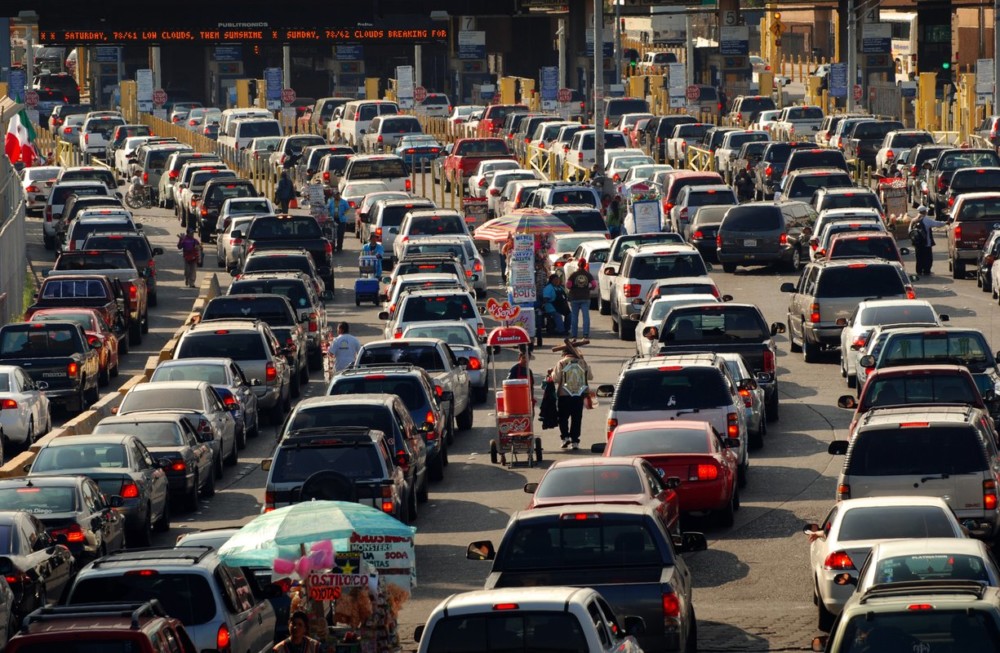If I were to ask you which land border crossing was the most trafficked in the world, would San Diego/Tijuana be the answer you come up with? That’s right, Tijuana, the city that has been embedded in American pop culture for decades , home of the Caesar Salad, and the one-of-a-kind Zonkey (Donkey + Zebra), has the busiest land port of entry globally with San Diego.
In 2016, according to the U.S. Governments Bureau of Transportation Statistics, over 10 million people crossed by foot and over 20 million passenger vehicles crossed at the San Ysidro and Otay Mesa border crossings. So what does all this traffic mean in a practical sense for everyday travelers? Anybody who has traveled to Tijuana and the Baja California region can tell you one thing — getting back to the United States is not fun.
Despite the awesome Baja-Med cuisine, the Guadalupe Wine Valley, even after having a blast in Baja, it creates a buzz kill having to sit in a border line that is unpredictable in nature. The Tijuana border line itself is usually slower than rush hour in Los Angeles. Sure, sometimes it can take as little as twenty minutes, but during peaks the time can easily reach an hour, two hours, or even five. This has a huge impact on both countries’ economies.
Sometimes it can take as little as twenty minutes, but during peaks the time can easily reach an hour, two hours, or even five.
Kenn Morris, President of Crossborder Group, a binational research firm based in San Diego, notes, “On average, in just San Diego County, visitors coming from Mexico spend over $10 million dollars each day – long delays can have direct impacts on our retail and our tourism sectors.” Many Americans in San Diego will not go to Tijuana just because of the border line and it has the reverse effect on San Diego. Many Mexicans won’t visit San Diego for the same reason or at a minimum, travel less frequent.
What if there was a better way to get across? That’s exactly where tech startups like BorderTraffic.com (or LaLineaEnVivo.com, the language Spanish variant), come into play. We’ve seen technology transform how we do many everyday tasks from controlling our finances, to telling us how to get to places with GPS. This app aims to do the same thing to border crossing by taking out the guesswork involved in crossing the border north into the US, and south into Mexico.
How an app can make crossing that much easier
So how does it work exactly? Their app allows you to view the border with near real-time video clips using a patented technology created by their parent company Solutions XYZ LLC. Using the app, you can see not only how long the lines are but how fast (or not so fast) the lines are moving. With so many options, three vehicle lanes at two ports of entry, seeing is believing. Yes, radio and TV give an estimate of how many cars are in the border at any given moment, but if they tell you 350 cars per lane, how long does that take? Are they moving fast? Are they moving slow? It is extremely difficult to judge that with traditional reports, even those from the CBP being infamously wrong.
This app will allow you to quickly see the border so that you can judge the wait time by seeing the speed and length of the border line, which lane, and which crossing you should jump into. The app also gives you options like picking lane view (standard, Ready, Sentri, etc) and time estimates, It’s also worth noting that it can give you a time estimate, helpful for tourists or infrequent border travelers who may not have a good idea of how long the border wait would be just by looking at the video.
The supplemental data is built using a proprietary algorithm that uses state-of-the-art video analytics to help create accurate border wait times. This is a living algorithm that partially uses crowd sourced data from users of the app timing themselves and is constantly being tweaked to stay as accurate as possible. Lastly, we want to highlight notifications.
Click the “My Alerts” button on the menu and click “Add Alert” to set specific criteria of when you want to alerted for. To use this feature, you simply set the location, how long the border line should be under, the day(s) and time(s) that the alert should occur, and how you want to receive the alert. The schedule will run automatically until you delete that specific schedule. This is another way you can use this app to help manage your time better. Instead of sitting in line for 3 hours, you can go about and do your thing, and simply be alerted when the border line has died down a little bit, making the wait more manageable.
The Border Traffic app is available on the Google Play Store. It is free to download and comes with a 30-day free trial. After the free trial Border Traffic offers two low subscription services: $4.99 for 1 year of service or for the occasional traveler $0.99 a month with the ability to cancel after each month of use.
Tech like smart borders are the future, but apps like this are a great starting point
As mentioned earlier, the unpredictable nature of the border costs both the U.S. and Mexican economies millions of dollars annually. As technology marches forward, we will likely see unique ways of addressing this problem, such as installing a “smart border” and creating other tools and government-supported resources to make life easier. For now, tools like BorderTraffic offer the best solution out there.
For the first time ever, you can look at the border in near-live time and make an educated decision as to when to cross, what crossing to use, and what lane to choose. Granted this isn’t likely the only app or serive of its kind, though it is one I have tested personally and have found to be very helpful.
Of course, it is not so helpful for those looking to cross elsewhere, like in Texas. Know of any other great apps or services that make crossing this border, or any US/Mexico border, easier? Let us know about them down in the comments.







